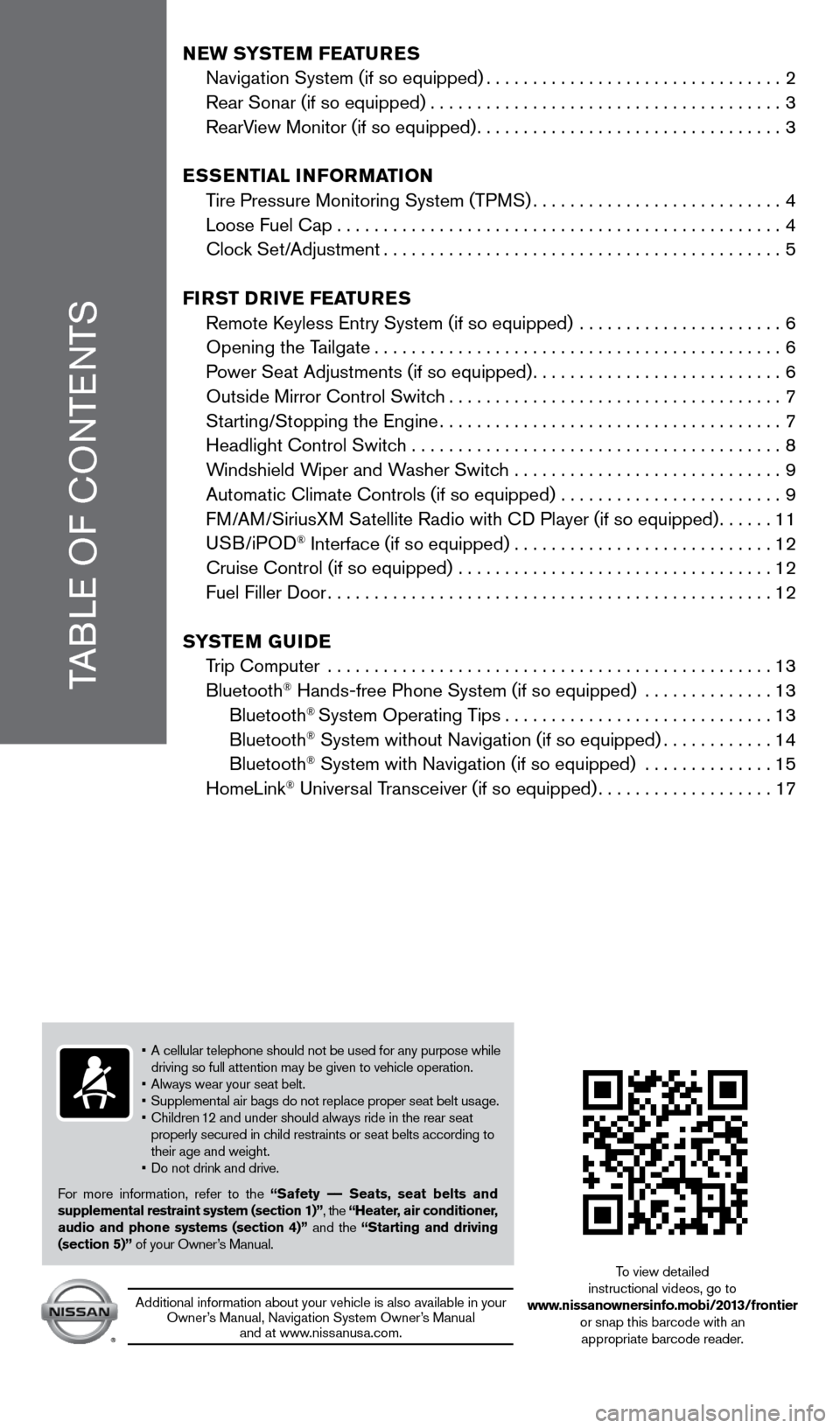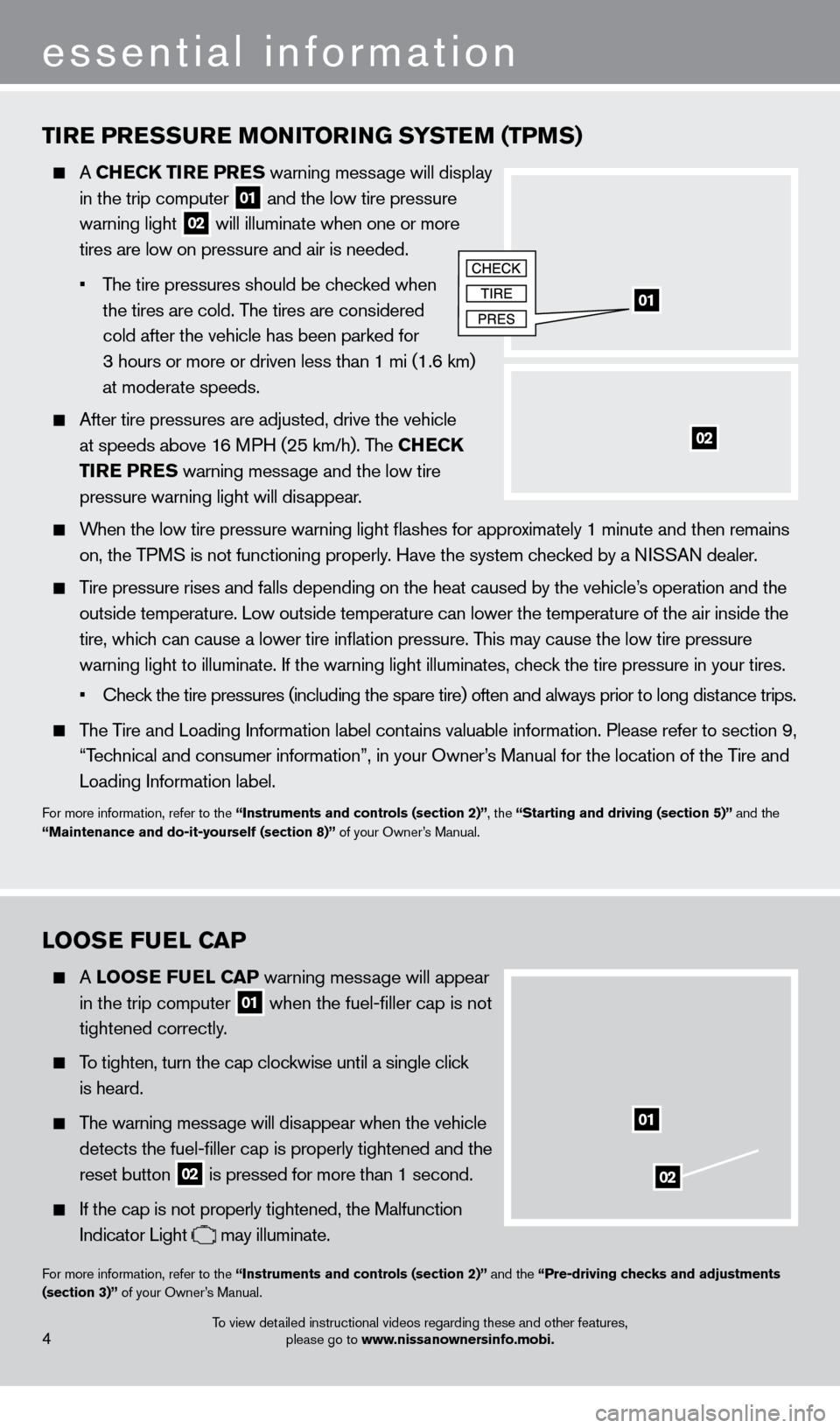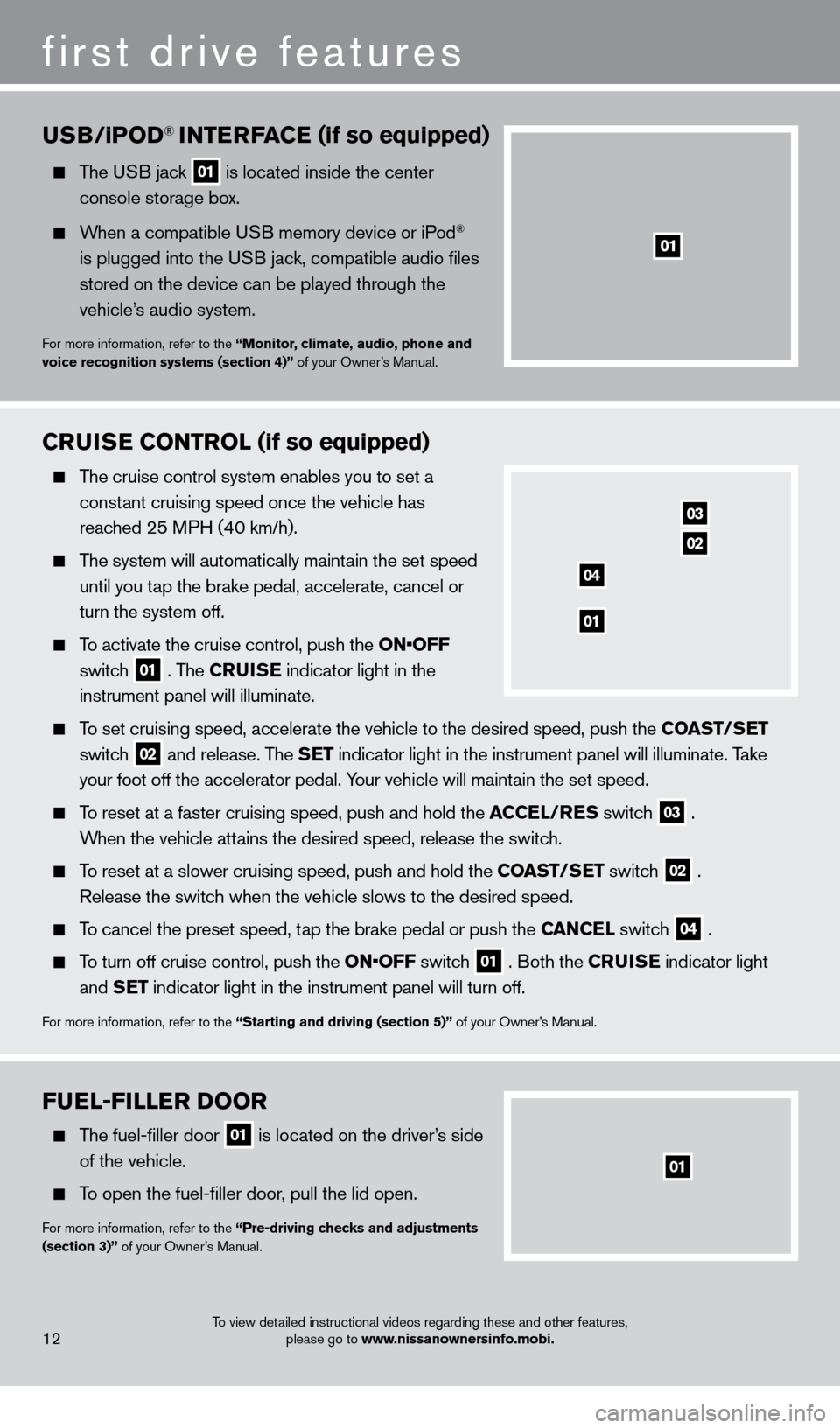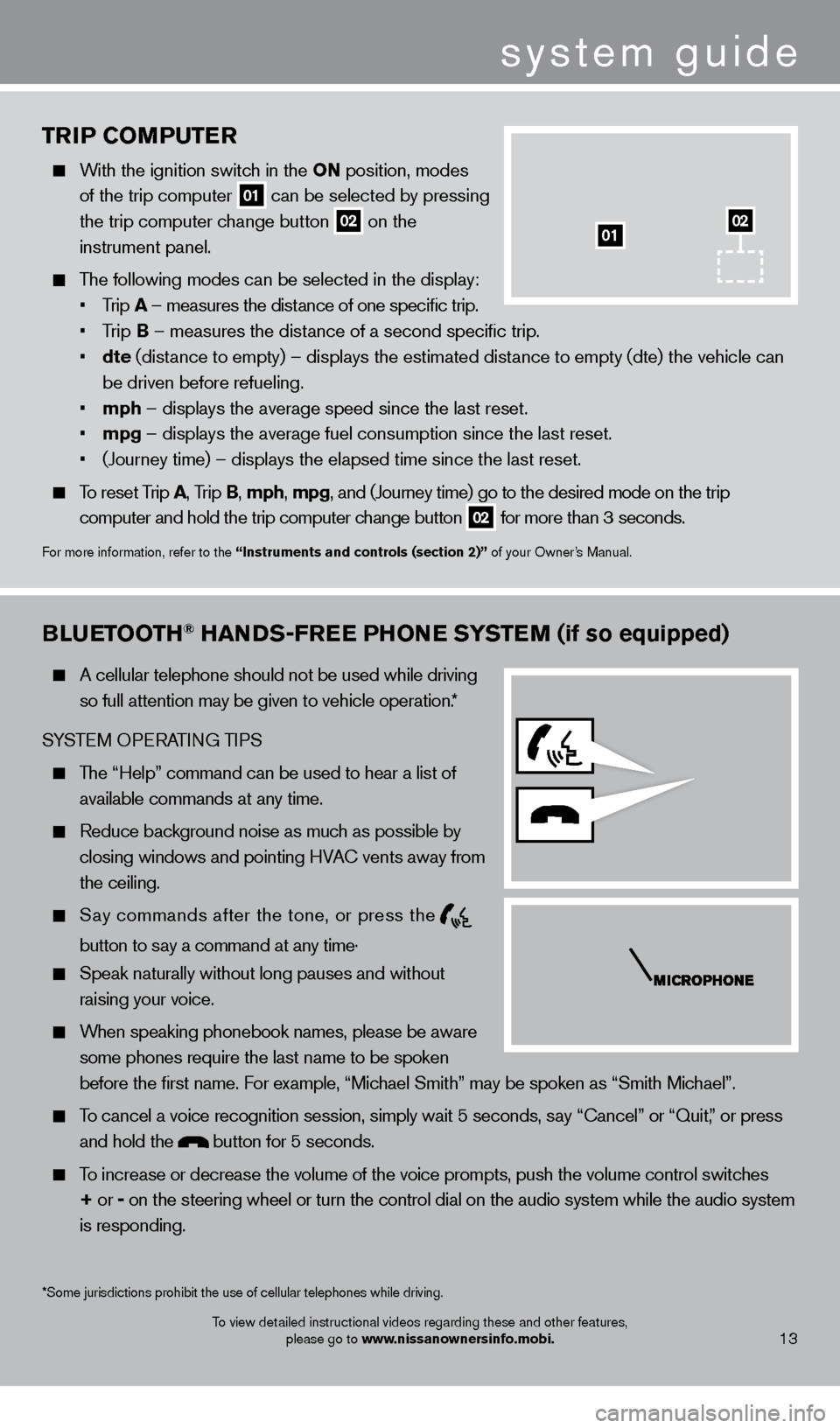2013 NISSAN FRONTIER fuel
[x] Cancel search: fuelPage 3 of 20

TABLE OF
c
O
NTENTS
NEW SYSTEM FEATURES
Navigation System (if so equipped)................................2
Rear Sonar (if so equipped)......................................3
RearV
iew Monitor (if so equipped)
.................................3
E
S
SENT i A l iNF
o
RMAT io N
T
ire Pressure Monitoring System (TPMS)
...........................4
Loose Fuel
c ap
................................................4
c lock Set/Adjustment
...........................................5
Fi
R
ST
DRiv
E
F
EATURES
Remote
k
eyless Entry System (if so equipped)
......................
6
Opening the T
ailgate
............................................6
P
ower Seat Adjustments (if so equipped)
...........................6
Outside Mirror
c ontrol Switch
....................................7
St
arting/Stopping the Engine
.....................................7
Headlight
c ontrol Switch ........................................
8
W
indshield Wiper and Washer Switch .............................
9
Automatic
c limate c ontrols (if so equipped) ........................
9
F
M/AM/SiriusXM Satellite Radio with c
D Player (if so equipped)......11
USB/iPOD
® Interface (if so equipped)............................12
c
ruise
c
ontrol (if so equipped) ..................................
12
Fuel Filler Door................................................12
S
Y
STEM
G
U
i
DE
T
rip
c
omputer ................................................
13
Bluetooth
® Hands-free Phone System (if so equipped) ..............13
Bluetooth® System Operating Tips.............................13
Bluetooth® System without Navigation (if so equipped)............14
Bluetooth® System with Navigation (if so equipped) ..............15
HomeLink® Universal Transceiver (if so equipped)...................17
• A cellular telephone should not be used for any purpose while driving so full attention may be given to vehicle operation.
•
Always wear your seat belt.
• Supplemental
air bags do not replace proper seat belt usage.
•
Children
1
2 and under should always ride in the rear seat
properly secured in c
hild restraints or seat belts according to
their age and weight.
• Do
not drink and drive.
For more information, refer to the “Safety –– Seats, seat belts and
supplemental restraint system (section 1)”, the “Heater, air conditioner,
audio and phone systems (section 4)” and the “Starting and driving
(section 5)” of your Owner’s Manual.
Additional information about your vehicle is also available in your Owner’s Manual, Navigation System Owner’s Manual and at www.nissanusa.com.
To view detailed
instructional videos, go to
www.nissanownersinfo.mobi/2013/frontier or snap this barcode with an appropriate barcode reader.
1275631_13a_Frontier_QRG_102612.indd 510/26/12 3:55 PM
Page 6 of 20

To view detailed instructional videos regarding these and other features, please go to www.nissanownersinfo.mobi.
essential information
TiRE PRESSURE Mo Ni To RiN G SYSTEM (TPMS)
A CHECK T iR E PRES warning message will display
in the trip computer
01 and the low tire pressure
warning light 02 will illuminate when one or more
tires are low on pressure and air is needed.
•
T
he tire pressures should be checked when
the tires are cold. T
he tires are considered
cold after the vehicle has been parked for
3 hours or more or driven less than 1 mi (1.6 km)
at moderate speeds.
After tire pressures are adjusted, d rive the vehicle
at speeds above 16 MPH (25 km/h). The CHECK
Ti
RE PRES warning message and the low tire
pressure warning light will dis
appear.
When the low tire pressure warning light flashes for approximately 1 minute and then remains on, the TPMS is not functioning properly. Have the system checked by a NISSAN dealer.
Tire pressure rises and falls depending on the heat caused by the vehicle\
’s operation and the
outside temperature. Low outside temperature can lower the temperature o\
f the air inside the
tire, whic
h can cause a lower tire inflation pressure. This may cause the low tire pressure
warning light to illuminate. If the warning light illuminates, c
heck the tire pressure in your tires.
•
Check the tire pressures (including the spare tire) often and always prior to long distance trips.
The Tire and Loading Information label contains valuable information. Please refer to section 9,
“T
echnical and consumer information”, in your Owner’s Manual for the location of the Tire and
Loading Information label.
For more information, refer to the “instruments and controls (section 2)”, the “Starting and driving (section 5)” and the
“Maintenance and do-it-yourself (section 8)” of your Owner’s Manual.
01
02
looSE FUEl CAP
A looSE F UEl CAP warning mess age will appear
in the trip computer 01 when the fuel-filler cap is not
tightened correctly
.
To tighten, turn the cap clockwise until a single click
is heard.
The warning message will disappear when the vehicle
detects the fuel-filler cap is properly tightened and the
reset button 02 is pressed for more than 1 second.
If the cap is not properly tightened, the Malfunction
Indicator Light may illuminate.
For more information, refer to the “instruments and controls (section 2)” and the “Pre-driving checks and adjustments
(section 3)” of your Owner’s Manual.
02
01
4
1275631_13a_Frontier_QRG_102612.indd 410/26/12 3:55 PM
Page 14 of 20

FUEl-F ill ER Doo R
The fuel-filler door
01 is located on the driver’s side
of the vehicle.
To open the fuel-filler door, pull the lid open.
For more information, refer to the “Pre-driving checks and adjustments
(section 3)” of your Owner’s Manual.
To view detailed instructional videos regarding these and other features, please go to www.nissanownersinfo.mobi.
CRUiSE Co NTRol (if so equipped)
The cruise control system enables you to set a
constant cruising speed once the vehicle has
reached 25 MPH (40 km/h).
The system will automatically maintain the set speed until you tap the brake pedal, accelerate, cancel or
turn the system off.
To activate the cruise control, push the ON•OFF
switch
01 . The CRU i SE
indicator light in the
instrument panel will illuminate.
To set cruising speed, accelerate the vehicle to the desired speed, push \
the C oAST/ SET
switch
02 and release. The SET indicator light in the instrument panel will illuminate. Take
your foot off the accelerator pedal. Your vehicle will maintain the set speed.
To reset at a faster cruising speed, push and hold the ACCE l/RES switc h
03 .
When the vehicle attains the desired speed, release the switch.
To reset at a slower cruising speed, push and hold the C oAST/ SET switch
02 .
Release the switch when the vehicle slows to the desired speed.
To cancel the preset speed, tap the brake pedal or push the CANCEl switch
04 .
To turn off cruise control, push the ON•OFF switch 01 . Both the CRU i SE
indicator light
and SET indicator light in the instrument panel will turn off.
For more information, refer to the “Starting and driving (section 5)” of your Owner’s Manual.
03
02
01
04
USB/ iPo D® iNTERFACE (if so equipped)
The USB jack
01 is located inside the center
console storage bo x.
When a compatible USB memory device or iPod®
is plugged into the USB jack, compatible audio files
stored on the device can be played through the
vehicle’s audio system.
For more information, refer to the “Monitor, climate, audio, phone and
voice recognition systems (section 4)” of your Owner’s Manual.
12
first drive features
01
1275631_13a_Frontier_QRG_102612.indd 1210/26/12 3:55 PM
Page 15 of 20

TRiP Co MPUTER
With the ignition switch in the o N position, modes
of the trip computer
01 can be selected by pressing
the trip computer change button 02 on the
instrument panel.
The following modes can be selected in the display:
• Trip A – measures the distance of one specific trip.
•
T
rip B – measures the distance of a second specific trip.
•
dte
(distance to empty) – displays the estimated distance to empty (dte) the vehicle can
be driven before refueling.
• mph – displays the average speed since the last reset.
• mpg – displays the average fuel consumption since the last reset.
• (Journey
time) – displays the elapsed time since the last reset.
To reset Trip A, Trip B, mph, mpg, and (Journey time) go to the desired mode on the trip
computer and hold the trip computer change button
02 for more than 3 seconds.
For more information, refer to the “instruments and controls (section 2)” of your Owner’s Manual.
01
Bl
UETooTH® HANDS-FREE PHo NE SYSTEM (if so equipped)
A cellular telephone should not be used while driving
so full attention may be given to vehicle operation.*
SYSTEM OPERATING TIPS
The “Help” command can be used to hear a list of available commands at any time.
Reduce bac kground noise as much as possible by
closing windows and pointing HVA
c
vents away from
the ceiling.
Say commands after the tone, or press the
button to say a command at any time .
Speak naturally without long pauses and without
raising your voice.
When speaking phonebook names, please be aware some phones require the last name to be spoken
before the first name. For example, “Michael Smith” may be spoken as “Smith Michael”.
To cancel a voice recognition session, simply wait 5 seconds, say “ c ancel” or “Quit,” or press
and hold the
button for 5 seconds.
To increase or decrease the volume of the voice prompts, push the volume \
control switches
+ or -
on the steering wheel or turn the control dial on the audio system while\
the audio system
is responding.
system guide
To view detailed instructional videos regarding these and other features, please go to www.nissanownersinfo.mobi.
*Some jurisdictions prohibit the use of cellular telephones while drivin\
g.13
02
1275631_13a_Frontier_QRG_102612.indd 1310/26/12 3:55 PM